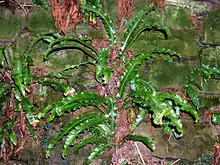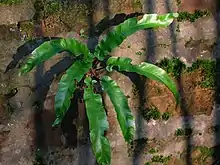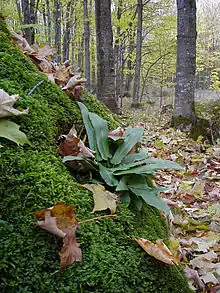| Asplenium scolopendrium | |
|---|---|
 | |
| Scientific classification | |
| Kingdom: | Plantae |
| Clade: | Tracheophytes |
| Division: | Polypodiophyta |
| Class: | Polypodiopsida |
| Order: | Polypodiales |
| Suborder: | Aspleniineae |
| Family: | Aspleniaceae |
| Genus: | Asplenium |
| Species: | A. scolopendrium |
| Binomial name | |
| Asplenium scolopendrium | |
| Synonyms | |
|
List
| |
Asplenium scolopendrium, commonly known as the hart's-tongue fern,[3] is an evergreen fern in the family Aspleniaceae native to the Northern Hemisphere.
Description
The most striking and unusual feature of the fern is its simple, strap-shaped undivided fronds. The leaves' supposed resemblance to the tongue of a hart (an archaic term for a male red deer) gave rise to the common name "hart's-tongue fern".
Taxonomy
Linnaeus first gave the hart's-tongue fern the binomial Asplenium scolopendrium in his Species Plantarum of 1753.[4] The Latin specific epithet scolopendrium is derived from the Greek skolopendra, meaning a centipede or millipede; this is due to the sori pattern being reminiscent of a myriapod's legs.[5][6]
A global phylogeny of Asplenium published in 2020 divided the genus into eleven clades,[7] which were given informal names pending further taxonomic study. A. scolopendrium belongs to the "Phyllitis subclade" of the "Phyllitis clade".[8] Members of the Phyllitis clade have undivided or pinnatifid leaf blades with a thick, leathery texture, persistent scales on their stalk, and often possess anastomosing veins. Members of the Phyllitis subclade have undivided leaves with freely branching veins and single or paired sori. They are widely distributed through the Northern Hemisphere.[9] Its closest relative within the subclade is A. komarovii, with which it forms a clade (the former segregate genus Phyllitis), sister to A. sagittatum.[8]
One variety and two subspecies are currently accepted:[10]
- A. scolopendrium subsp. scolopendrium, is native to Europe and North Africa;
- A. scolopendrium var. americanum, is native to the United States, Mexico and Ontario in Canada;
- A. scolopendrium subsp. antri-jovis, is native to Greece, Crete and Turkey.
Morphological differences between the varieties are minor, but the North American variety americanum is tetraploid, while the Old World subspecies A. scolopendrium scolopendrium) is diploid.[11]
Distribution
Asplenium scolopendrium is a common species in the Old World:
- The subspecies scolopendrium occurs throughout Europe (including the Caucasus and the British Isles), the Middle East, and North Africa (in Morocco, Algeria, Tunisia and Libya, as well as the Canary Islands). It has also been introduced to the Falkland Islands. A. scolopendrium var. scolopendrium is rarely found in North America. Unlike its American counterpart, the scolopendrium of Europe is used for many horticultural uses. [12] [13] Specimens of this variety found in North America (such as in New Brunswick and Ontario in Canada, and Maryland in the United States) are considered naturalized descendants of cultivated plants.[14]
In North America, it occurs in rare, widely scattered populations located in different locales:
- in the Mexican states of Chiapas, Coahuila, Nuevo León, and Oaxaca, as well as the Caribbean island of Hispaniola (in Haiti).[15]
- along the Onondaga Limestone and Niagara Escarpment geological formations in Central New York (present in 2 counties), southern Ontario (present in 7 counties), and the eastern Upper Peninsula in Michigan (present in 2 counties). Exceptions are disjunct populations that exist in Alabama (in Fern Cave National Wildlife Refuge, a wildlife refuge centered around an off-limits cave in Jackson County, Alabama, where it has declined heavily due to illegal plant collecting, and an undisclosed pit in Morgan County that is also off-limits and protected), and Tennessee (in just a single county); these southern populations are at dire risk of extirpation.[16][17] An introduced population descended from New York plants is found in New Jersey; it is a remnant of a 1936 effort to practice ex-situ conservation of populations in New York.[18]
- In 2020, a new population of hart's-tongue ferns was discovered inside a cave with basaltic lava flows in El Malpais National Monument, Cibola County, New Mexico; this represents the first confirmed population of the species in North America west of the Mississippi. Genetic analyses and surveys are currently being performed to determine the population's variation and overall health. [19]
The unique dispersal of Asplenium scolopendrium has caught the attention of international botanists. In fact, the very existence of such varieties beg that "...these populations arose following colonization events involving a single spore".[20]
Habitat
The plants grow on neutral, calcium-rich, and/or lime-rich substrates under deciduous hardwood canopies (usually sugar maples in eastern North America), including moist soil and damp crevices in old walls; they are found most commonly in shaded areas. Plants in full sun are usually stunted and yellowish in colour, while those in full shade are dark green and healthy. The disjunct populations of the North American variation in the southeastern US are found exclusively in sinkhole pits or limestone caves.[21] These populations may be relics of cooler Pleistocene climates.[17]
Conservation
United States
In the United States, A. scolopendrium var. americanum was declared endangered by the U.S. Fish and Wildlife Service in 1989.[21] The reasons for its rarity are currently being researched, with reintroduction programs in New York and elsewhere also in development.[22]
Canada
Ontario, Canada has the highest population numbers of A. scolopendrium var. americanum of any region in the variation's distribution, with around 80% of all subpopulations and around 94% of all individuals. The fern was reported at more than 100 sites across the province, with around 75 still believed to be existing. Despite this, A. scolopendrium var. americanum was listed as a species of Special Concern under the Committee on the Status of Species at Risk in Ontario in May 2017, due to its extremely specific habitat requirements, relatively small distribution, and some subpopulations consisting of too little individuals.[23][24]
Europe
In spite of being much more common in Europe than in North America (and therefore present in more protected areas), A. scolopendrium is still declining in certain areas of the continent. The fern was listed as "Vulnerable" in the National Red Lists for Albania in 2014[25] and Norway in 2010 (under Criterion D1);[26] considered "critically threatened and rare" in the Czech Republic's 2012 plant Red List;[27] and "Endangered" in Sweden's 2010 Red List.[28] However, it was not considered threatened in Germany's 1996 Red List of Threatened Plants.[29] A. scolopendrium is protected by law in the Netherlands since 1998.[30]
Uses
Cultivation
Asplenium scolopendrium is often grown as an ornamental plant, with several cultivars selected with varying frond form, including with frilled frond margins, forked fronds and cristate forms. The species has gained the Royal Horticultural Society's Award of Garden Merit,[31] as has the cultivar 'Angustatum'.[32]
The American variety is reputed to be difficult to cultivate (making conservation efforts for it even more troublesome); due to this, most, if not all, cultivated individuals are derived from the Old World subspecies.[33]
Herbal medicine
This fern was used in the 1800s as a medicinal plant in folk medicine as a spleen tonic (hence an archaic name for the genus, "spleenworts") and for other uses.[34]
Gallery
 Habitat
Habitat A cultivar with frilled frond margins
A cultivar with frilled frond margins A specimen growing in lime mortar on a wall
A specimen growing in lime mortar on a wall Example of the North American variety
Example of the North American variety
References
- ↑ "NatureServe Explorer 2.0". Explorer.natureserve.org. Retrieved 16 March 2022.
- ↑ "NatureServe Explorer 2.0". Explorer.natureserve.org. Retrieved 16 March 2022.
- ↑ BSBI List 2007 (xls). Botanical Society of Britain and Ireland. Archived from the original (xls) on 2015-06-26. Retrieved 2014-10-17.
- ↑ Linnaeus 1753, p. 1079.
- ↑ Harrison, Lorraine (2012). RHS Latin for Gardeners. United Kingdom: Mitchell Beazley. ISBN 978-1845337315.
- ↑ "Flora Europaea Search Results". Websites.rbge.org.uk. Retrieved 16 March 2022.
- ↑ Xu et al. 2020, p. 27.
- 1 2 Xu et al. 2020, p. 30.
- ↑ Xu et al. 2020, p. 41.
- ↑ "Asplenium scolopendrium L." Plants of the World Online. Royal Botanic Gardens, Kew. Retrieved 18 March 2023.
- ↑ "Asplenium scolopendrium var. americanum in Flora of North America". Efloras.org. Retrieved 16 March 2022.
- ↑ Pence, V. C. (2015, July). Propagation and cryopreservation of Asplenium scolopendrium var ... - JSTOR. American Fern Journal. Retrieved March 17, 2023, from https://www.jstor.org/stable/44076071
- ↑ "Asplenium scolopendrium L. | Plants of the World Online | Kew Science". Plants of the World Online. Retrieved 16 March 2022.
- ↑ Kartesz, J.T. 1999. A synonymized checklist and atlas with biological attributes for the vascular flora of the United States, Canada, and Greenland. First edition. In: Kartesz, J.T., and C.A. Meacham. Synthesis of the North American Flora, Version 1.0. North Carolina Botanical Garden, Chapel Hill, N.C.
- ↑ "Tropicos | Name - Asplenium scolopendrium L." Legacy.tropicos.org. Retrieved 16 March 2022.
- ↑ "Species Status Assessment : Report for the American Hart's-tongue Fern (Asplenium scolopendrium var. americanum)". Ecos.fws.gov. November 2019. Retrieved 16 March 2022.
- 1 2 Short, John W.; Spaulding, Daniel D. (2012). Ferns of Alabama. Tuscaloosa, AL: University of Alabama Press. ISBN 9780817356477.
- ↑ Snyder, D.B. 1990. Botanist, New Jersey Natural Heritage Program. Personal communication with Wayne Ostlie, MRO, The Nature Conservancy.
- ↑ "Archived copy" (PDF). Archived from the original (PDF) on 2021-11-11. Retrieved 2021-11-11.
{{cite web}}: CS1 maint: archived copy as title (link) - ↑ Weston L. Testo, James E. Watkins Jr, John Wiley, Laura Baumann, Eric Weaver "SHORTER NOTE," American Fern Journal, 111(3), 217-222, (2 September 2021). Retrieved March 17, 2023, from https://bioone.org/journals/american-fern-journal/volume-111/issue-3/0002-8444-111.3.217/SHORTER-NOTE/10.1640/0002-8444-111.3.217.short
- 1 2 Currie, Robert R. (September 1993). American hart's-tongue recovery plan (PDF) (Report). Atlanta, Georgia: U.S. Fish and Wildlife Service. Retrieved 2010-02-28.
- ↑ Michael Serviss. "Experimental Reintroduction of American Hart's-Tongue Fern (Asplenium scolopendrium var. americanum) : Factors Affecting Successful Establishment of Transplants". Digitalcommons.esf.edu. Retrieved 16 March 2022.
- ↑ "Ontario Species at Risk Evaluation Report for American Hart's-tongue Fern (Asplenium scolopendrium var. americanum)" (PDF). Cossaroagency.ca. Retrieved 16 March 2022.
- ↑ "American Hart's Tongue Fern". Ontario.ca. Retrieved 16 March 2022.
- ↑ "The National Red List Project | A focal point for national red lists and species action plans". Nationalredlist.org. Retrieved 16 March 2022.
- ↑ Kålås, J.A., Viken, Å. and Bakken, T. (eds). 2006. Norsk Rødliste 2006 – 2006 Norwegian Red List. Artsdatabanken.
- ↑ Grulich, V. 2012. Red List of vascular plants of the Czech Republic: 3rd edition. Preslia 84: 631-645.
- ↑ Gärdenfors, U. 2010. Rödlistade arter i Sverige - The 2010 Red List of Swedish Species. ArtDatabanken, SLU, Uppsala.
- ↑ Ludwig, G. and Schnittler, M. 1996. Red List of Threatened Plants in Germany (Rote Liste gefährdeter Pflanzen Deutschlands). Bundesamt für Naturschutz, Bonn.
- ↑ "Flora- en faunawet". Wetten.overheid.nl. Retrieved 16 March 2022.
- ↑ "RHS Plant Selector - Asplenium scolopendrium". Rhs.org.uk. Retrieved 12 February 2020.
- ↑ "Asplenium scolopendrium 'Angustatum'". Rhs.org.uk. Retrieved 20 February 2020.
- ↑ Mickel, John T. (2003). Ferns for American Gardens. Timber Press. ISBN 9780881925982. This book is a reprinting of Mickel, John T. (1994). Ferns for American Gardens. MacMillan. ISBN 9780025844919.
- ↑ Hill, John (1812). The family herbal: or An account of all those English plants, which are remarkable for their virtues, and of the drugs which are produced by vegetables of other countries; with their descriptions and their uses, as proved by experience. C. Brightly and T. Kinnersley. p. 162.
- Linnaeus, C. (1753). Species Plantarum. Vol. II (1st ed.). Stockholm: Laurentii Salvii.
- Xu, Ke-Wang; Zhang, Liang; Rothfels, Carl J.; Smith, Alan R.; Viane, Ronald; Lorence, David; Wood, Kenneth R.; Cheng, Cheng-Wei; Knapp, Ralf; Zhou, Lin; Lu, Ngan Thi; Zhou, Xin-Mao; Wei, Hong-Jin; Fan, Qiang; Chen, Su-Fang; Cicuzza, Daniele; Gao, Xin-Fen; Li, Wen-Bo; Zhang, Li-Bing (2020). "A global plastid phylogeny of the fern genus Asplenium (Aspleniaceae)". Cladistics. 36 (1): 22–71. doi:10.1111/cla.12384. PMID 34618950. S2CID 201197385.
Further reading
- Hyde, H. A., Wade, A. E., & Harrison, S. G. (1978). Welsh Ferns. National Museum of Wales. ISBN 0-7200-0210-9.
- Parker, Rosemarie (December 2009). "A Real Rarity". Finger Lakes Native Plant Society. A popular article on hart's tongue fern that includes several references and a discussion of cultivation possibilities for the European and American varieties. The article strongly discourages collection and or cultivation of the North American variety.

